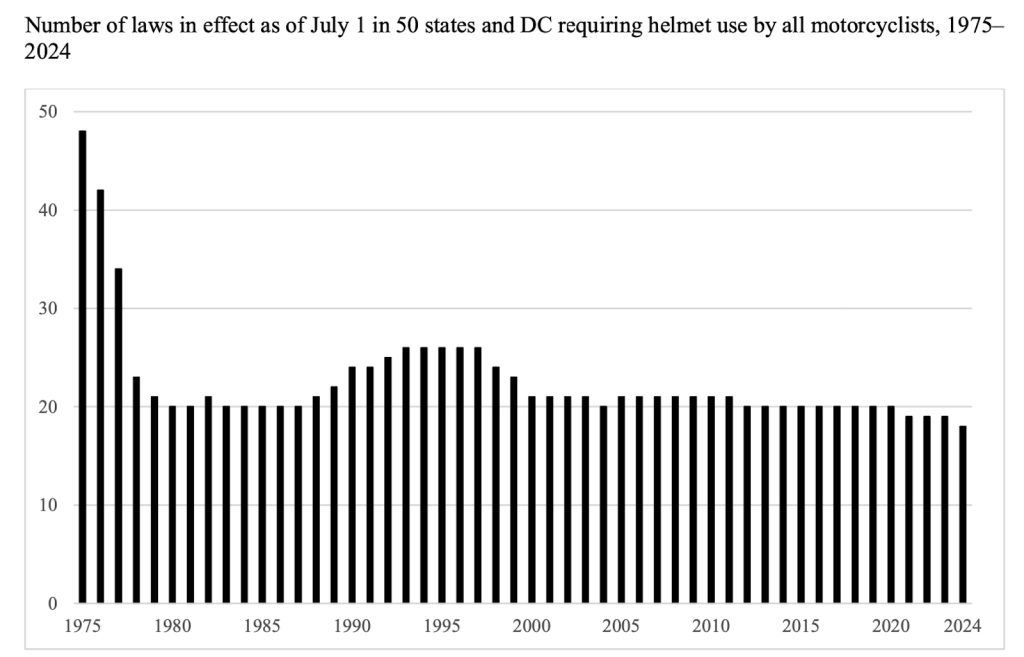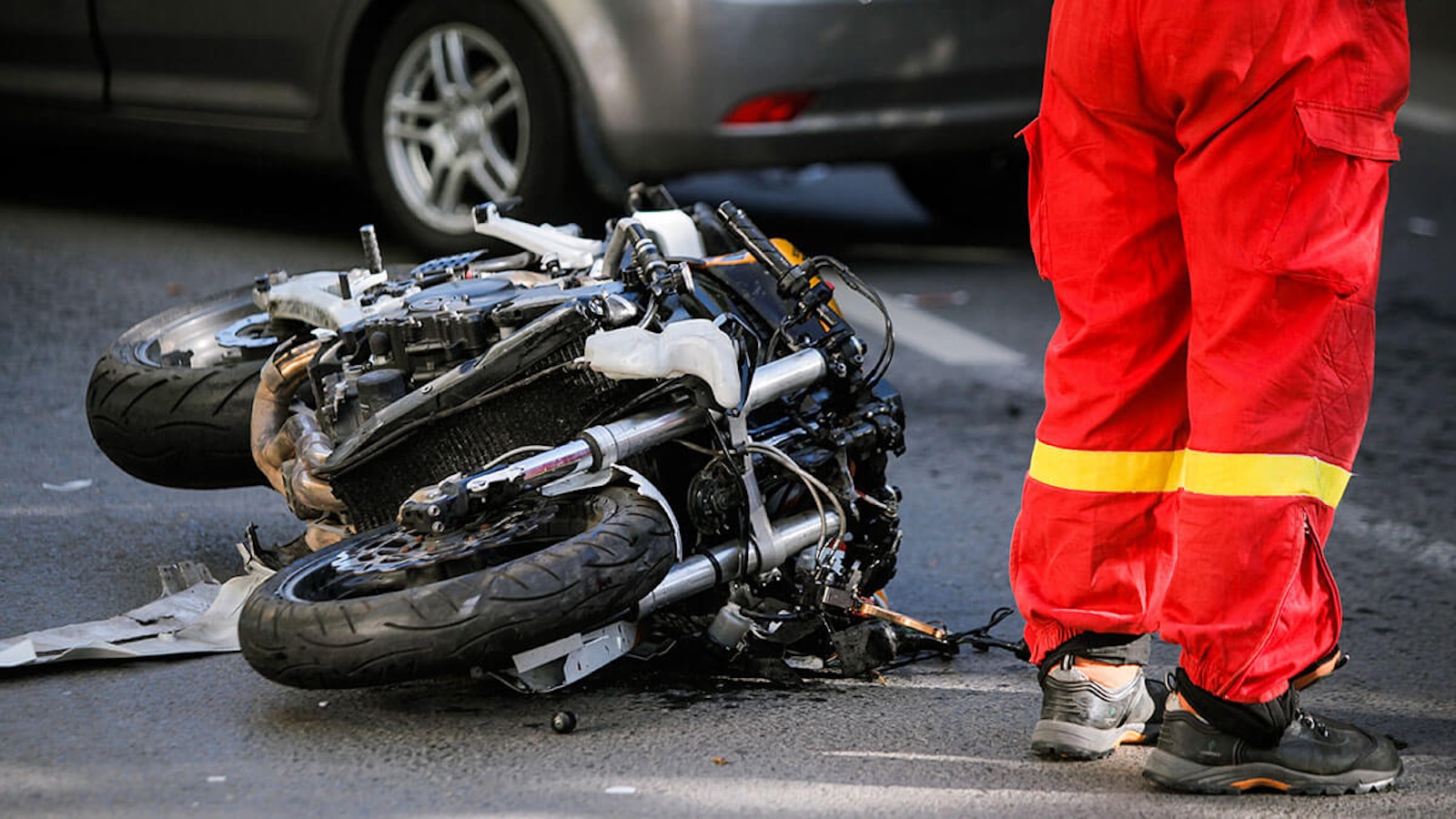Helmet laws often create discord among motorcyclists, the medical community and other safety experts. The latest study from the Insurance Institute for Highway Safety isn’t likely to quell any of the disagreements. The report shows more than 22,000 riders would have survived fatal crashes during the last four decades.

A new study from the IIHS shows that more than 22,000 motorcyclists would have survived fatal crashes during the past four decades if they’d worn helmets.
According to the IIHS study, if all states employed mandatory helmet laws between 1976 and 2022, a total of 22,058 riders would have been saved. The number accounts for 11% of all rider deaths during the period.
“Requiring all riders to wear helmets is a commonsense rule not that different from requiring people in cars to buckle up,” said IIHS President David Harkey. “We have an obligation to protect everyone on our roadways through smart policy.”
Currently, just 17 states as well as the District of Columbia, require all riders to wear helmets. IIHS officials claim that if the remaining 33 states enacted similar laws, deaths would be reduced by 10%.
Not quite that simple
Those who oppose mandatory helmet laws do so for a variety of reasons. Some of them are focused on the freedom that riding a motorcycle offers, including the “wind through your hair” experience.
Others note that helmets are not the only issue related to improving motorcyclist safety. The American Motorcyclist Association “strongly encourages” the use of helmets and other personal protective equipment, such as gloves, footwear and more. However, it doesn’t support laws requiring their use.
“The AMA believes that adults should have the right to voluntarily decide when to wear a helmet,” the group notes. “The AMA asserts that helmet use alone is insufficient to ensure a motorcyclist’s safety. There is a broad range of other measures that can be implemented to improve the skill of motorcycle operators, as well as reduce the frequency of situations where other vehicle operators are the cause of crashes that involve motorcycles.”
Where did they come from

The American Motorcyclist Association says technology, such as anti-lock brakes, will make a bigger difference than mandatory helmet laws.
The first helmet laws hit the books in 1967, according to the IIHS. The number of states mandating helmets grew to 47 by 1975. The growth came as a result of the National Highway Safety Act tied federal highway safety and construction funding to requiring motorcyclists to ride helmets.
However, the restriction ended in 1976 — why the study’s timeframe begins then — helmet laws have steadily weakened. Many states started by requiring riders only under a certain age (usually 21 or 18) wear helmets; however, others eliminated them entirely. This shift came as safety belt rules became more ubiquitous.
The push for safety belts is often cited by those pushing for mandatory helmet laws. The AMA refutes the comparison noting, “Mandatory helmet laws do nothing to prevent crashes. Regardless of the protective equipment worn, any motorcyclist involved in a crash is at considerable risk.”
More Motorcycle Stories
- Kawasaki Unveils Hydrogen-Powered HySE Motorcycle
- Bentley and Ducati Reveal Limited Edition Motorbike
- A Week With: 2024 Polaris Slingshot Roush Edition
More education
One concept safety experts and motorcycle advocates agree on is the need to find ways to reduce the odds of a motorcycle crash before it happens.
The AMA advocates for more voluntary motorcycle rider education, improved licensing and testing, and increased public awareness. All are measures that can reduce the likelihood of crashes and improve overall safety.
The group notes 22% of riders involved i n crashes in 2011 were operating their bikes without a valid license. Perhaps more concerning to riders are vehicle drivers who don’t pay attention, often not seeing motorcycles on the road.
n crashes in 2011 were operating their bikes without a valid license. Perhaps more concerning to riders are vehicle drivers who don’t pay attention, often not seeing motorcycles on the road.
Additionally, 49% of all fatal motorcycle crashes involve another vehicle, the group noted. The most common crash involves the driver of the other vehicle turning in front of the motorcyclist (38%), followed by both vehicles colliding while going straight (23%).
“Motorist awareness campaigns and motorcyclist conspicuity programs can reduce the frequency and/or severity of these types of crashes,” AMA officials note.
Still, helmets work
IIHS believes technology to detect motorcycles as well as anti-lock brakes for the bikes could also improve rider safety. But it’s critical that education and technology work hand-in-hand with helmet usage to make a difference.
“Wearing a helmet is one of the biggest things riders can do to protect themselves from death and traumatic brain injury,” said Eric Teoh, IIHS director of statistical services and the author of the paper. “We understand that requiring helmets for all riders everywhere would be unpopular with some motorcyclists, but this could save hundreds of lives each year. Those aren’t just numbers. They’re friends, parents and children.”
Despite those against the mandatory use of helmets, population-level helmet use has increa sed over time in jurisdictions with and without all-rider helmet laws, the study said. However, helmet use rates in states with all-rider laws were generally 2-3 times as high as in states without them over the study period.
sed over time in jurisdictions with and without all-rider helmet laws, the study said. However, helmet use rates in states with all-rider laws were generally 2-3 times as high as in states without them over the study period.
Additionally, statistics show that not only do the largest number of fatalities occur in states with no mandatory helmet laws, the numbers continue to rise. The association notes that riders should be the ones making the choice.
“The AMA holds that a common principle should be applied when consideration is given to mandating personal safety, whether it be for motorcycling or some other risk-related activity: Adults are capable of making personal safety decisions for themselves,” the organization said.
“Society’s role is not to mandate personal safety, but rather to provide the education and experience necessary to aid adults in making these decisions for themselves.”






0 Comments